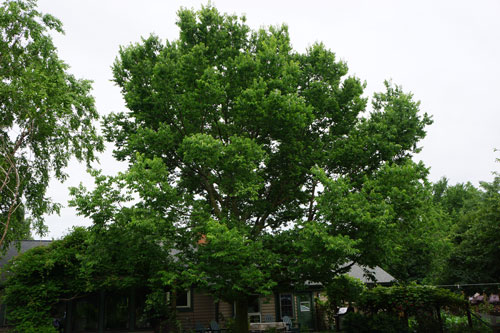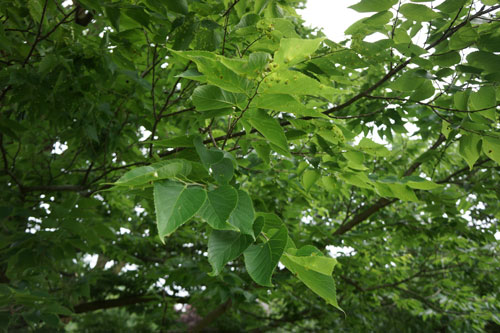June Wisdom from the Trees
/Tree of the Month
Hackberry • Celtis occidentalis
Hackberry, Celtis occidentalis, is a native Illinois tree that has much to commend it. It is very hardy in our area, it has a relatively fast growth rate, an interesting bark, and dark green heart shaped leaves. It was one of the first trees we planted in our new home landscape just over 20 years ago now. You can see it has reached to about 25’ tall and 22” in diameter. The most common pest it has is a tiny harmless adelgid insect that creates small galls or nipple shaped bumps on the leaves. These nipple galls are so ubiquitous that many people think they are part of the tree’s natural habit.
Hackberry has a yellow fall color and is a great shade tree. We planted it over our patio to provide shade that we enjoy gratefully every summer against a western afternoon sun.
The Native peoples valued the common Hackberry for medicinal, food and ceremonial purposes. The fruit of the common Hackberry were mixed with fat and corn to add flavor to foods. Medicinally it was used in a decoction to aid in gynecological remedies and the bark was used in decoctions to help with sore throats.
Who was that masked man?
Backyard Wisdom by Gilbert A Smith
ISA Certified Master Arborist
Our clients trust Arborsmith to use non-toxic or very low toxicity pesticides to save their trees. For many people its a surprise when they first see us wearing spray masks. Please don’t be concerned because, WEARING A MASK IS ACTUALLY A HEALTHY SIGN.
None of the pesticides that we use require or even suggest the use of a spray mask. We wouldn’t use them if they did. Even when using organics like Soap or Dormant Oil it is much more healthy for us if we are not constantly breathing the mist.
None of the sprays that we use are stronger than common cleansers or soaps that you use in your own home. If you were breathing those all day it could be harmful.
So why is a spray mask a good sign? Though it is a bother and is often surprising to our clients, it is a sign that we care about the health of our employees. If we care about our employees this way, you can be sure that we care about the health of our clients and our environment. But you already knew this. Arborsmith does not use any highly toxic pesticides, in fact we try to avoid any pesticide use if we can, while keeping your trees healthy.
So when you see a masked man (or woman) from Arborsmith thank them for being careful while they save your trees.
High Ho Silver......Away!
HoneyBee Update
Mother Nature's Moment
by Lesley Bruce Smith ISA Certified Arborist
This month we were featured on Dig In® Chicago, an all local Garden-to-kitchen TV show. In keeping with that theme I thought we might share some of the ways we use our gardens for sustaining life.
As a third year beekeeper, I help to transform our backyard prairie into a honeybee haven. Last summer was not only extra hot for us, but it was hard on the plants and the bees. Along with many other beekeepers in Northern Illinois, I had my hives “swarm”. It is a natural occurrence but a little unsettling when you walk into the back yard and see thousands of honey bees flying around...”ooohh, this is not normal!”
When a hive swarms they have hatched a young new queen and the older experienced queen takes about a third to a half of the worker girls and leaves the hive to find a new home, all this to give the original hive more room to grow. It is Nature’s way of reproducing, but lots of things can go awry making survival a challenge. I have often wondered how the queen communicates who will stay and who will go. Do they count off by twos? It’s quite fascinating to contemplate and even though it mystifies me, the bees know exactly what to do.
As a bee keeper, if you have extra hive bodies and equipment you can try to capture the experienced queen and her kin and provide them a new home nearby. I was actually able to do this. When you have 30,000 bees buzzing about is an interesting task. Picture organized chaos, the bees aren’t confused, just me. We did manage to capture the first swarm and even a second.
However, they did not all survive. Before the end of the long hot summer I experienced a hive robbing, which is where another colony of bees comes in and systematically kills off a weaker hive and steals all their honey. I don’t know if the marauding bees were from my other hive or from somewhere else but it was very sad to have thousands of little dead bees in front of the hive and find it empty of honey. The robbing all happened in two days. Leaving me with one hive.
This all sounds like an exercise in complex math and gives you a sense of how complicated this can all get. This spring I was left with one hive from bees produced here in Lake County and I have purchased another new queen to bring my hives up to two again. I am very grateful for my bee mentor, Larry Steuder, who helped me and taught me how to sort all this out.






